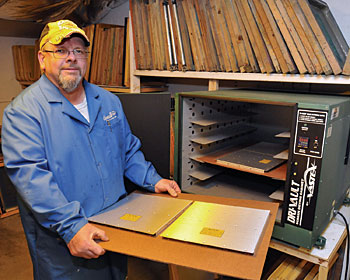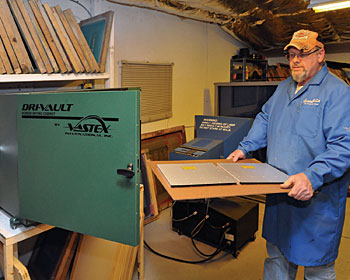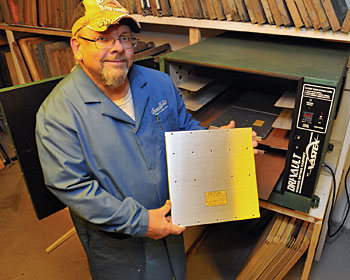MARLTON, NJ — ScreenTech, Inc. has built a thriving business by screen-printing on an endless variety of industrial metal components for electronics, aerospace, automotive, defense and communications applications, jobs that many other printers find difficult, impossible or simply unprofitable. The company often works with design engineers to configure novel ways to apply identification and images on prototypes, or on short production runs.
The company recently purchased a Vastex drying cabinet with a custom secondary heater-blower unit capable of raising temperatures to 140° F (60° C). The heat is needed to rapidly, thoroughly cure inks printed on metal surfaces, cutting drying times from hours to minutes.
Starting with Sheet Metal
ScreenTech owner Dennis Hallahan's background is integral to the story. At age 19, he began working in a sheet metal fabrication shop. After several years he became the resident screen printing expert and was constantly challenged by new, difficult assignments of printing text and graphics on irregularly shaped parts.
In 1985 he established ScreenTech as a full service screen printer doing apparel, signage, vehicles, custom embroidery and metal components. Today, however, approximately 90 percent of his company's business involves printing on metal. "Our expertise goes into designing the job, making a specialized screen and a custom fixture to hold the part. Artwork does not always come into us the right way and we alter it to make it screen printable for these unusual jobs," Hallahan explained.
ScreenTech's clients typically fabricate metal parts, especially in the electronics, aerospace, automotive, defense and communications industries. The company often works with design engineers to configure novel ways to apply identification and images on prototypes as well as on production parts.
Incoming parts are fabricated of aluminum, steel and stainless steel, either unpainted, painted or power coated. "Not all parts are flat, but come in different sizes and shapes. Some are crazy looking. We build custom fixtures, or jigs to hold them, which is the unique capability we developed over the years, along with special screen techniques and configurations to deal with the assortment of shapes," said Hallahan. The custom screens and jigs are used for printing on recessed and raised sections, irregularly curved or shaped surfaces and to navigate protruding elements.
Responding to Client Needs
"We were searching for a way to speed up the drying process because deadlines are so short these days. We often work like maniacs. The other day we had a client flying to India with a prototype of a new electronic product for the broadcast industry. We rushed to print the job in time for the client to make his flight," a feat made possible by the new drying cabinet. "Ink that would have previously taken overnight to dry was fully cured in the double-heater dryer in less than a half hour. To some degree we are able to charge extra for fast turnaround. We may get a 30 percent premium," said Hallahan.
Finding the Solution
Hallahan had been looking for better ways of drying inks on metals. For some metals jobs he employed an unconventional approach by using a tee shirt conveyor-dryer, but parts over six inches in height would not fit through the unit. Air drying was taking too long.
An Internet search for a better method to dry emulsions on printing screens serendipitously led Hallahan to an ideal solution for curing of inks on metal parts. "Originally, I just wanted to dry screens, but when I learned of the Vastex two-heater option I was able to kill two birds with one stone. I'm getting a high performance piece of equipment, almost like a miniature oven that is superior to other cabinets I have seen costing three times more."
The Vastex Model VDC-253610 that ScreenTech purchased measures 35 in. wide x 38 in. deep x 30 in. high (88.9 x 96.5 x 76.2 cm) and can be raised to 53" high (134.6 cm) with optional legs. The dryer holds up to 10, 25 x 30 in. (63.5 x 76.2 cm) screens up to 1.625 in. (4.13 cm) thick. It comes standard with an industrial stainless steel heater and a blower that provides 290 cfm (4.25 cm) air flow. Using the standard blower, ScreenTech added a second heater. A sealed door, a replaceable intake air filter and a pressurized air flow system keep screens and metal parts clean.
Faster Turnarounds, Higher Quality
"To dry a printing screen you do not want to exceed 100 degrees, but with the extra heater I was able to raise the temperatures from 100 to about 140 degrees," (38° to 60° C) said Hallahan. "Now I can adjust the unit to dry both screens as well as metal parts. To accommodate thicker metal parts, I remove as many tray holders as necessary. Average air drying time for two-part epoxy ink on metal is at least 24 hours. With the custom dryer I can knock it down to a half hour. If I use an enamel ink it's probably an hour. About ten minutes for a quick-drying decal ink. It's a really nice way of speeding up production and improving quality. Unlike air drying, the cabinet minimizes particulate contamination. To our company, it's all about packing up a great job and getting it out to the customer."
ScreenTech, Inc.
+ (856) 809-9459
www.screentechink.com












